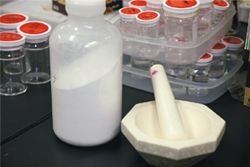| Versatile
ceramics support new technological developments in a
wide variety of fields including semiconductors, information
and communications, mechanics and the environment. They
are also used as a biomaterial, such as artificial bone,
in the life sciences due to their excellent biocompatibility.
It is possible to make different types of ceramic even
from the same precursors by changing the composition
or heat-treatment conditions. Thus much of its potential
as a material still waits to be discovered. In this
program, students learn methods for making ceramics
as well as methods for analyzing such features as its
electromagnetic, biological and thermal characteristics.
We introduce not only the conventional method of combining
and firing powders but also comparatively newer methods
in which liquidus precursors are gelled before firing.
Students will make ceramics and investigate their properties
by themselves. |
 |
|